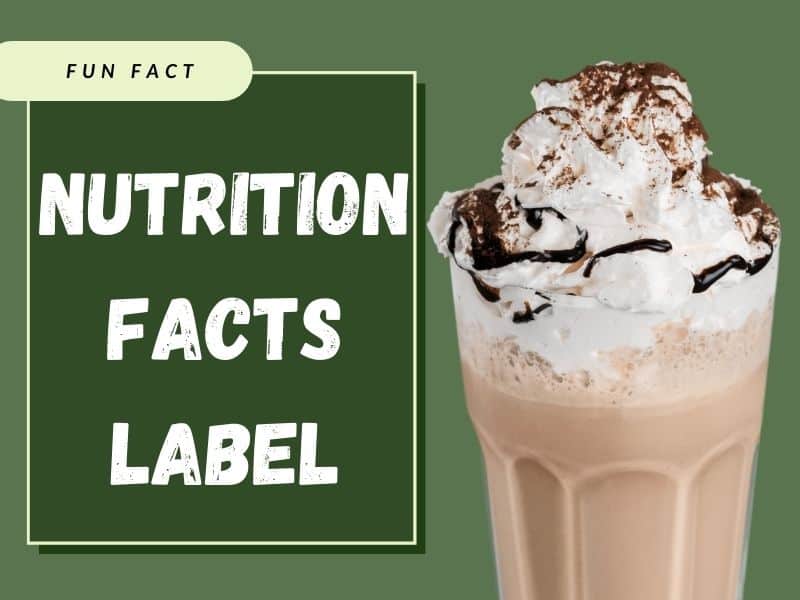As people nowadays find themselves more and more concerned about what they eat, the need to read and comprehend food labels has been critical. Among the children’s drinks, chocolate milk stands out the most but is also very common among adults, it’s not only casually drunk but it is also used within lunches or packed for school and the gym. Then again, how much do you really know about what goes in that carton?
This article seeks to explain the Food Labels for Chocolate Milk and more specifically the components of its key components so that the readers are able to interpret the information and make healthy decisions in future.
What Is Chocolate Milk?
Chocolate milk refers to sweetened or flavored milk which consists of cocoa powder and sugar or other sweet substances blended with normal milk. There are many such drinks with added vitamins and minerals and they are said to be very nutritious. Such milk, whole, low and nonfat varieties offers a satisfactory solution to every type of diet.
Understanding the Nutrition Facts Label

The Nutrition Facts label will give you the most accurate insight into the nutrients that chocolate milk contains. Let’s see how this is done step by step:
Serving Size
The serving size of the chocolate milk has been indicated in the nutrition facts and measures the amount of chocolate milk regarded as one serving. In the case of chocolate milk, this is usually 240 ml or 1 cup. It is perhaps most important to understand the serving size because all of the nutritional information found on the label corresponds with it.
https://youtu.be/qdf2D_FarQo
Calories
Calories energy expenditure for a single serving is measured using calories. This is also the reason why chocolate milk is usually higher in calories than ordinary milk. Based on the catering company and fat content, a single serving’s worth of Standard milk would fall anywhere between 150 to 200 calories.
Total Fat
Total fat includes any fat contained per serving. Whole chocolate milk is definitely late; maximal amounts of saturated fat can be too much. Nevertheless, it may be essential to manage one’s overall consumption of fats, particularly saturated fat, as fatty deposits can be harmful to the heart. Roughly 3 to 5 grams of total fat are present in one serving of milk, while approximately 2 to 3 grams are saturated fat.
Cholesterol
Cholesterol is a type of fat that is present in the tissues of animals. In the case of milk, the served amount (one serving) does not have a considerable amount of cholesterol, for it is about 10 to 15mg. Many diets prohibit the consumption of dietary cholesterol for various reasons; the impact it may have on heart health remains ambiguous, for those who have certain health issues, it is advisable to pay attention to how much of it you consume.
Sodium
Sodium is a salt mineral that has high importance albeit in small amounts in the body. However, sodium levels in chocolate milk differ from one server to another, with the average sodium levels in chocolate milk being 100-150 mg per serving proportion. Diets rich in sodium are linked to the elevation of blood pressure; this should be taken into account while making meals.
Total Carbohydrates
The term total carbohydrates refer to the total sugar, total fiber, and total starch content in one serving size. In chocolate milk, the bulk of the carbohydrates are made up of sugars, and more specifically of added sugars. A standard serving contains roughly 25 to 30 grams of total carbohydrates with approximately 20 grams as sugars.
Added Sugars
This segment is of great importance for the consumers of chocolate. Added sugars are supplementary sugars which are added in the process of treatment and these can lead to other health problems such as diabetes and obesity. Ice-cream and chocolate milk with less added sugar should be sought. Less sugar products have become the target of many brands as it is attractive to the health conscious consumers. No more than 10 grams of sugar per serving should be observed for chocolate.
Dietary Fiber
Dietary fiber aids in proper digestion of food. Unfortunately, as regards chocolate, it usually contains very low or no fiber at all as it comes from animal sources. However, consuming foods that are rich in fiber alongside chocolate milk can greatly assist in ensuring a balanced diet.
Protein
In terms of benefits, protein is important in a lot of ways, one of them including helping with muscle development and repair. A particular type of chocolate milk has roughly 8 grams of protein which means it is a good source of protein along with several other nutrients. This is one reason why many active or workout oriented individuals prefer having it.
Vitamins and Minerals
Other reasons why residents of Milwaukee love flavored milk is due to its nutritional value, as chocolate milk is often loaded with additional vitamins and minerals such as calcium and vitamin D. Calcium is an important factor for the strength of bones while vitamin D is essential for the proper absorption of calcium. Chocolate milk on the other hand can provide up to 30% calcium and 25% vitamin D for a single serving.
Why Are The Ingredients Important: Efficacy and Nutrition
The ingredients list indicates what the constituents of your milk are. The proportions of many important nutrients are given to the most important ones, and they are placed in order of the burn list. The ingredients used in chocolate milk include:
- Milk: The most important supply, which contains various nutrients that our body requires.
- Cocoa Powder: Utilized for flavoring and also a source of antioxidants.
- Sugar: Used to whiten up the milk. Choosing those with lower sugar content is ideal.
- Vitamins and Minerals: Calorific elements such as vitamins D and calcium that are frequently added to boost nutrition.
Evaluating Different Types One Should Try When Shopping for Chocolate Milk
It is interesting to look for different brands and variations of chocolate milk. In this regards, let me offer several tips to keep you healthy:
- Look at the Nutritional Value: Focus on calorie and fat content and sugar content trying to pick one brand over the other.
- Do not Forget to Look for Low-Sugar Products: Many brands stock low-sugar chocolate milk or do not use any sugar in production which will greatly lower your consumption.
- Look for Organic or Natural Foods: These usually have fewer preservatives and artificial ingredients.
- Look for Lactose-Free or Vegan Products: For those who are lactose-intolerant or prefer plant diets many brands make chocolate milk with almond, soy, or oat milk which is lactose free or plant based.
Comparing Chocolate Milk Options
But Everyone Does Not Order Milk and It Doesn’t Have to Be a Treat. In Fact, It’s Very Healthy, Especially For People Who Are Active:
- Recovery Will Be Important After Exercise: It is said that carbs work really well with proteins to promote muscle less from glycogen stores and repair muscle tissue and chocolate milk has both feels like a miracle.
- Hydration Will be Easy to Achieve: Water is abundant in chocolate milk which would make it easy for excessive hydration after exercise.
- Serves as a good Primary Nutri-In: It is also a source of calcium, vitamin D, and protein which chocolate milk supplement makes quite useful.
Possible Disadvantages
Either way, chocolate still has its cons, aside from its advantages. Here are some points to keep in mind:
- Excessive Sugar Intake: Added sugars may be present in numerous varieties of chocolate milk and when consumed in excess, may cause weight gain and other health complications.
- High Caloric Content: It may be good after an exercise, however when it’s taken often without other nutritious components, chocolate milk is likely to add extra calories.
Healthy Choices
If chocolate milk is to be taken but with only a few adverse effects, look for the following options:
- Restrained: Don’t drink chocolate every day, rather, use it in small amounts from time to time.
- Use as a Complement: When enjoying chocolate, always do so with a proper meal, adding fruits, whole grains or nuts for added nutrition.
- Make Your Own Chocolate Milk: A good alternative would be to make your chocolate by using cocoa powder that is free from sweeteners and honey or maple syrup as a sugar source. This way you are able to manage the usage of sugar.
Conclusion
Knowledge about the nutrition information of chocolate sachets helps in making dietary decisions. A slight change in calorie intake depends on regular chocolate and skim or low-fat milk containing 22 to 35 calories per cup, so checking the nutrition facts, reading the ingredient list, and researching other chocolate brands will help in making the healthiest choices. It doesn’t have to be a quick meal or a treat during weekends; chocolate is also good for workouts and as an addition to the breakfast meals.


